
Campbellana is a genus of moths of the Carposinidae family, containing only one species, Campbellana attenuata. This species is endemic to the Campbell Islands of New Zealand.

Sabatinca demissa is a species of moth belonging to the family Micropterigidae. It is endemic to New Zealand and is found in the northern half of the North Island. The larvae of this species are small in size and are coloured pale green with darker green or black patches on the rear of its body. The adult moth is coloured yellow-brown with black dots on its forewings. It is a small moth with a wingspan of approximately 6.5 mm in length. Unlike many species of moth, it does not have a pheromone communication system. The adults of the species are on the wing from November to January. The larvae of this species feed on leafy types of liverwort. The adults of this species feed on the spores of fertile cones of Lycopodium volubile and Lycopodium scariosum.

Izatha prasophyta is a moth of the family Oecophoridae. It is endemic to New Zealand, where it is known from the North Island, except Hawkes Bay or the Wairarapa. Larvae likely feed on rotting wood although larvae of this species have been reared on the fruiting body of the bracket fungus Bjerkandera adusta. Adults are on the wing from November to February.

Heterocrossa iophaea is a species of moth in the family Carposinidae. It is endemic to New Zealand and has been observed in both the North and South Islands. This species inhabits native forest. The larvae feed on the seeds of the mataī tree, Prumnopitys taxifolia. Adults are on the wing from October to February. They are nocturnal and are attracted to light. During the day the adult moths rest on the trunks of trees or hide among the twigs and leaves on the ground.
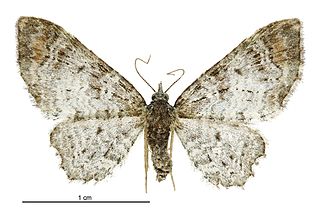
Pasiphila aristias is a species of moth in the family Geometridae. It was described by Edward Meyrick in 1897 and is endemic to New Zealand. This species is found in both the North and South Islands and inhabits subalpine and native forest. Adults are on the wing in December and January and are attracted to light.
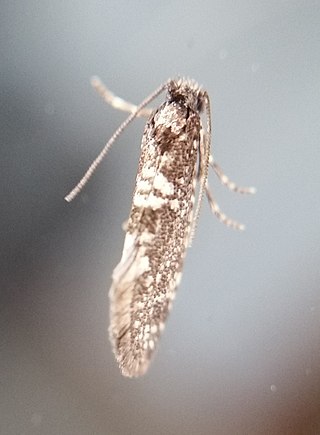
Scoriodyta conisalia is a species of moth in the family Psychidae. It was described by Edward Meyrick in 1888. It is endemic to New Zealand and can be found in the North Island. It has been observed at Karikari, Paihia, in the Poor Knights Islands, and in the Auckland and Wellington regions. The species inhabits native forest and coastal areas where it can be found on rocky outcrops and cliffs. Larvae consume algae and lichens. The adults are on the wing from September to March and are active before sunrise.

Apoctena taipana is a species of moth of the family Tortricidae. It is endemic to New Zealand and has been observed in both the North and South Islands. The larvae created a silken tube in which they hide and also use to travel from leaf to leaf. They tunnel into the leaves of their host. Larvae can be found from June to August. Adult moths can be seen on the wing from October to January.
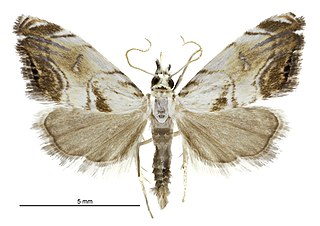
Glaucocharis harmonica is a moth in the family Crambidae. This species was described by Edward Meyrick in 1888. It is endemic to New Zealand and is found in the North and South Islands. It inhabits lowland to subalpine native forest. It has been hypothesised that there are two broods per year. The larval hosts are unknown. Adults are on the wing from October until January.
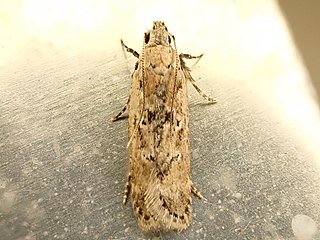
Anisoplaca achyrota is a species of moth in the family Gelechiidae. It was first described by Edward Meyrick in 1885 and is endemic to New Zealand. This species has been observed in both the North and South Islands and inhabits native forest. The larvae of this species feed on the green seeds of Hoheria angustifolia and as such is regarded as an indicator species for mature native forest. The adults of the species are commonly on the wing from December until February and are attracted to light.

Anisoplaca fraxinea is a species of moth of the family Gelechiidae. It was described by Alfred Philpott in 1928 and is endemic to New Zealand. It has been observed in the South Island and adults are on the wing in February and March.

Anisoplaca ptyoptera is a species of moth in the family Gelechiidae. It was described by Edward Meyrick in 1885 and is endemic to New Zealand. This species is found throughout the North and South Islands and prefers habitat where its host plants are common. The larval hosts of this moth are species in the genus Carmichaelia and the larvae stem mine the host plant. However larvae have also been observed feeding on gorse species and as a result their potential as a biological control for gorse has been researched. This behaviour has only been recorded in the Canterbury and Otago regions. A. ptyoptera overwinters as larvae and while in that life stage can be parasitised by species of wasp in the genera Zealachertus and Diadegma. Pupation begins in October. Adult moths are on the wing from October until May with peak emergence occurring in January. The adult moths come in two size classes and should the size of the female be in the larger class fecundity is improved. It is likely that this species has only one brood a year.
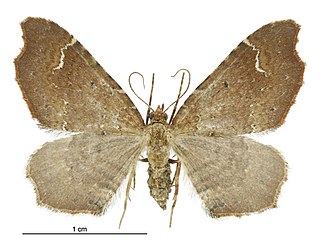
Asaphodes camelias is a species of moth in the family Geometridae. It is endemic to New Zealand, has been observed in both the North and South Islands and inhabits native forest. The adults of this species are on the wing from February to May and July to September.

Zapyrastra calliphana is a species of moth of the family Momphidae. It was first described by Edward Meyrick in 1889. It is found throughout New Zealand including at the Manawatāwhi / Three Kings Islands as well as at the Norfolk Islands. The preferred habitat of this species are native forest clearings, shrubland or coastal habitat such as scrub or dunes. The larvae of this species are leaf miners and are hosted by Muehlenbeckia species. There are likely several generations during the New Zealand summer and one generation overwinters as pupae. This species is a day flying moth and adults can be observed on the wing from October to March.

Hierodoris callispora is a moth of the family Oecophoridae. It is endemic to New Zealand and can be found throughout the country from south of the Bay of Plenty. This species inhabits native beech forest. Adults of the species have been found where Muehlenbeckia is common. Adults have also been collected from the flowers of Kunzea ericoides. However the larval host is unconfirmed although it has been hypothesised that larvae of this species feed on Kunzea ericoides flowers. Adults of this species can be distinguished by its orange ruff that contrasts with its dark head and thorax. There is a colour form that exists that has orange scales and an orange coloured fringe on the hindwing. Adults have been collected in December and January and are day flying but are also attracted to light at night. A female specimen has been found with a larva in her oviduct suggesting that this species may give birth to larval young.

Hierodoris frigida is a moth of the family Oecophoridae. It is endemic to New Zealand and is only found in the South Island. This species is found in two parts of that island, the Nelson/Tasman area and the Mackenzie, Otago and Dunedin areas in the southern part of the island. Although similar to H. iophanes this species can be distinguished as H. frigida has white bands on its forewings and the metallic coloured areas differ in placement. Segment 2 on the labial palp is entirely yellow and enables this species to be distinguished from the similar appearing species H. polita and H. torrida. Larvae have been collected amongst leaf litter from beneath species within the genus Thymus. It prefers open and shrubland habitats and adult moths have been observed flying close to the soil underneath Leptospermum scrub.
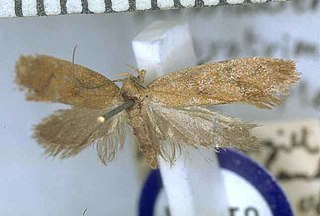
Tingena paratrimma is a species of moth in the family Oecophoridae. It is endemic to New Zealand and has been observed in the lower parts of the South Island. George Hudson regarded this species are uncommon. The adults of this species are on the wing from November to February.

Tingena penthalea is a species of moth in the family Oecophoridae. It is endemic to New Zealand and has been observed in Wellington and the Tararua Range. The adults of this species are on the wing from December until February.
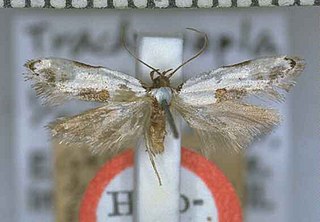
Trachypepla hieropis is a moth of the family Oecophoridae first described by Edward Meyrick in 1892. It is endemic to New Zealand and has been collected in both the North and South Islands. This species inhabits native forest and the larvae feed on leaf litter. Adults are on the wing in December and are attracted to light.

Trachypepla lichenodes is a moth of the family Oecophoridae first described by Edward Meyrick in 1883. It is endemic to New Zealand and has been found in both the North and South Islands. It inhabits native forest and adults of this species are on the wing from November to January. The adult moths are similarly coloured to native lichen species however this colouration is variable in the extent and depth on the forewings.

Orthenches chartularia is a moth of the family Plutellidae first described by Edward Meyrick in 1924. It is endemic to New Zealand and can be found in the North and South Islands. This species inhabits open grassy areas in native subalpine forest. Adults are on the wing in January and February.





















